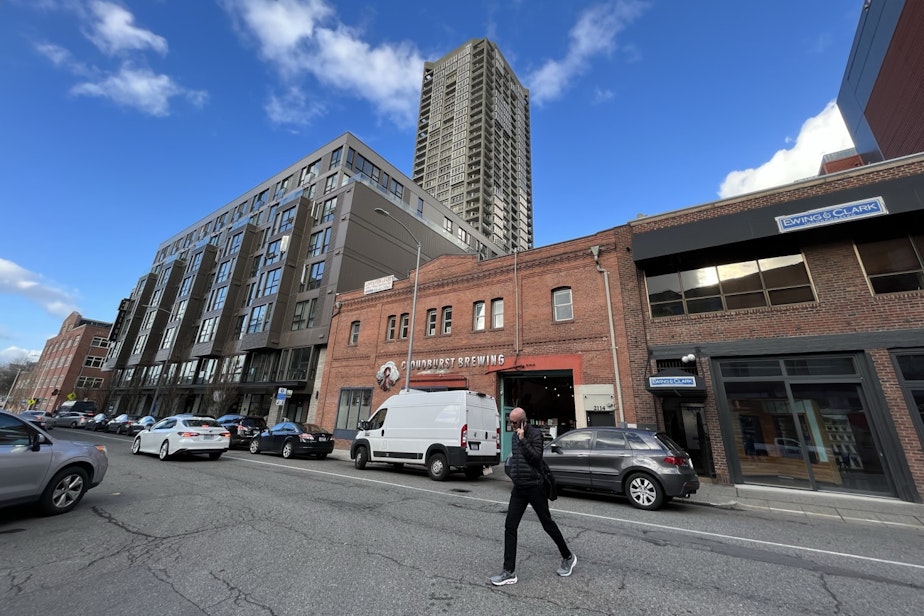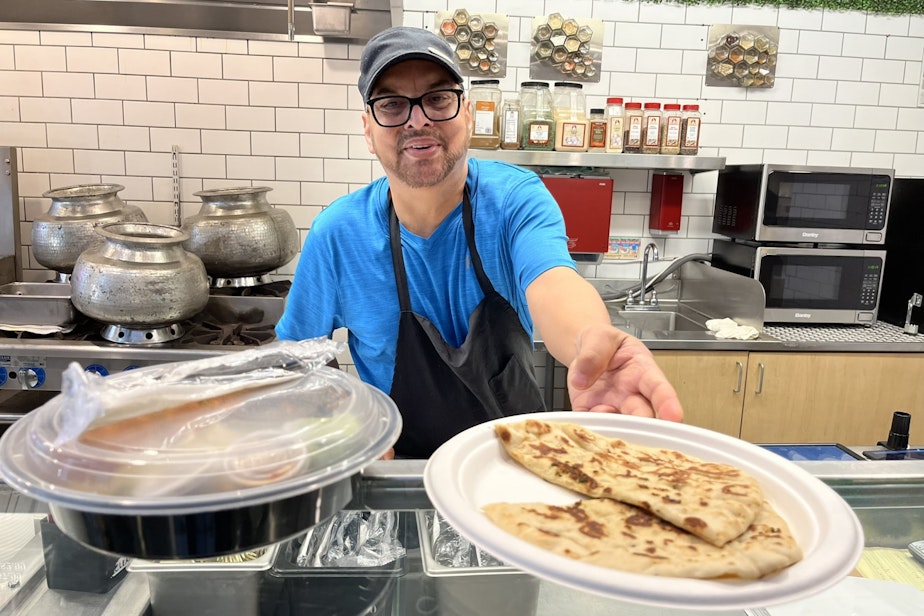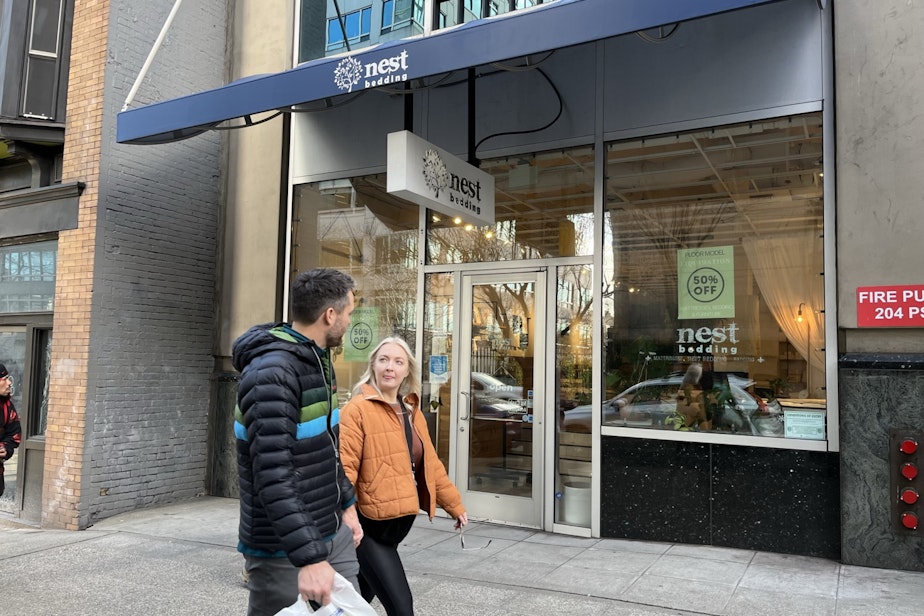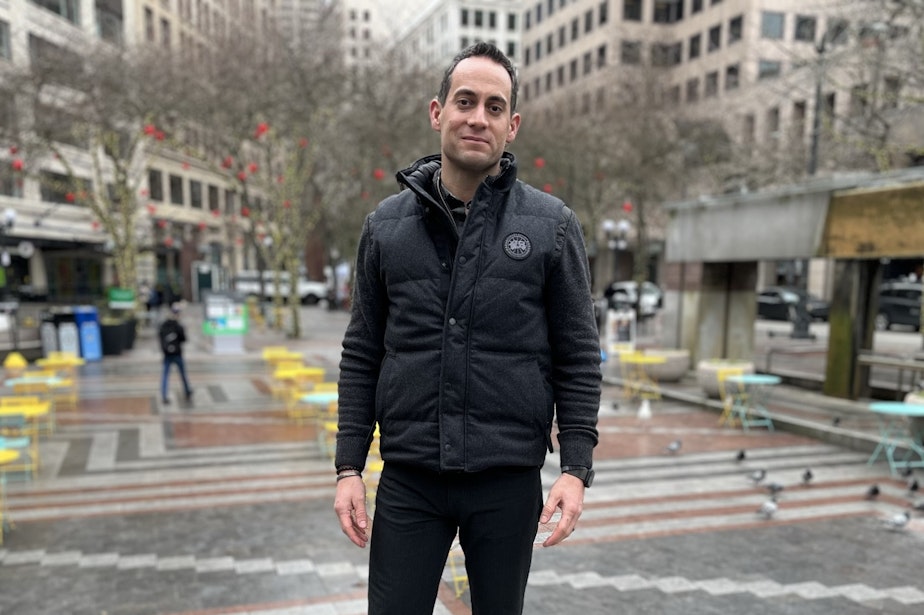With office employees gone, downtown Seattle residents became the neighborhood's economic lifeblood

Downtown Seattle was decimated by the pandemic. Office buildings are 22% vacant right now — that’s like one in five towers being dark. But the downtown core is showing surprising signs of life.
KUOW growth and development reporter Joshua McNichols went to figure out why, in Part 1 of our 3-part series, “Dowtown Reimagined.,”
I
n downtown Seattle, there’s a food court under an office building near Westlake Park. Office workers used to be a huge part of the customer base for restaurants there.
Pankaj Kakkar used to eat at Café Zum Zum regularly. But now, he only comes into the office once a week.
“I usually just eat at home. There’s always leftovers from the weekend, or there’s something frozen in the fridge, so it ends up being something like that,” he said.
The loss of regular customers has been hard on the owner of the Pakistani restaurant, Shaw Mahmood.
“We are barely surviving, you know. I work very hard for my life. I don’t want to leave like this. I’m a fighter. I’m going to keep going, as long as I can,” he said.
Sponsored

Foot traffic in downtown is about a third higher than it was this time last year, but not every business is seeing the benefits of that.
There’s a distinct pattern in which kind of businesses are struggling — and which are doing OK. Those that depend on office workers are hurting, but many that cater to downtown residents are doing much better.
Sponsored
Alchemy, a high end furniture store in Belltown, had a great final quarter last year. Just around the corner, Erin Meyer manages a store that sells bedding.

Sponsored
When you walk in Nest, it's filled with the sound of tropical birds.
"It’s what the people upstairs want me to do," Meyer said, adding that it’s part of the whole "nest” theme. “At some point, you just tune it out.”
Meyer said her store has seen a lot of customers coming in lately — people furnishing their nests.
“I’d say it’s definitely local folks, so we get a lot of folks in the area,” meaning people who live in condos and apartments nearby, she explained. “There’s actually an apartment building right above us, so we get a lot of those folks."
RIPPLE EFFECT: How people are pushed farther and farther out of Seattle
Sponsored
The residents have been essential to making this business more resilient, and to downtown's overall economic recovery. But like most downtown businesses, it's not just the residents helping Nest thrive — tourists and other visitors help, too.
“Things are really getting back to normal again,” Meyer said.
Sponsored
In 2021, the New York Times ranked downtowns in terms of how dependent they were on offices. Boston and San Francisco ranked poorly, because they’re dominated by office buildings. Boston is 83% office towers; San Francisco's 74%.
But in Seattle, only half of downtown is office space. This puts Seattle at a relative advantage right now, when so many offices are vacant.
RELATED: How are tech layoffs impacting downtown businesses?
This is not by accident — it’s the result of years of city planning.
In the 1980s, downtowns everywhere were struggling because so many people had moved to the suburbs. To draw people downtown again, elected leaders changed Seattle’s zoning to encourage residential towers, and improved the public transportation system.
Sponsored

Jon Scholes is the president and CEO of the Downtown Seattle Association. He said Belltown was one of the first downtown neighborhoods to benefit from this planning.
“Belltown still is one of the more dynamic neighborhoods in downtown, and has evolved and changed over the years, but still has a lot to offer, a lot of great nightlife and bars, because there’s a built-in customer base that isn’t heading for the hills at 5 o’clock every night,” Scholes said.
Since the 1980s, the residential population downtown has quintupled from about 20,000 people to over 100,000 today.
Scholes said that makes Seattle’s downtown residential population one of the fastest growing of any city in North America.
And there are another 5,000 apartments in the permit pipeline.
As impressive as that is, it’s not enough new homes to meet pent-up demand. And some experts say high interest rates could slow housing development down for awhile, even as demand grows more.
But what if Seattle’s problem could be turned into a solution?
Seattle’s downtown is suffering because of vacant and underused offices. At the same time, the region needs more housing. That has a lot of people asking: Why don’t we convert more downtown offices to apartments?
In Part 2 of our series "Downtown Reimagined," we’ll go to Tacoma to see why the city has become a hotbed for this approach — and look at whether it could work for Seattle.
This series debuted as a mini-documentary on KUOW's program, Soundside.




